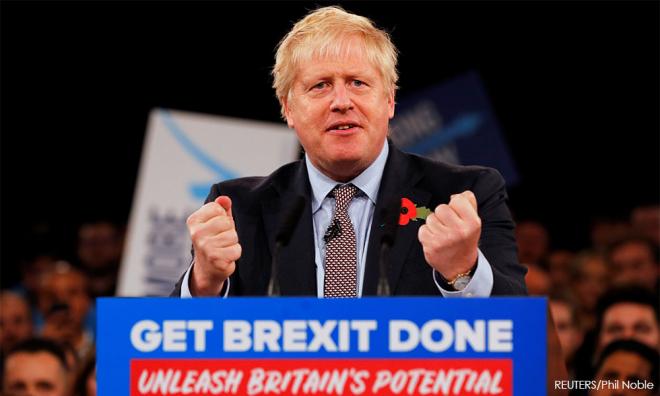
The United Kingdom voted on June 23, 2016, to leave the European Union.
It will finally leave at 2300 GMT on Jan 31 after what has been a tortuous road in and out of membership.
London declined to join the EU’s forerunner, the European Coal and Steel Community (ECSC) when it was founded in 1952.
Prime Minister Clement Attlee said his Labour Party would not accept the economy being “handed over to an authority that is utterly undemocratic and is responsible to nobody”.
Britain also stayed out of the European Economic Community (EEC) when it was formed from the ECSC in 1957.
Conservative Prime Minister Harold MacMillan reversed this position in 1961 and sought membership of the EEC, saying European unity was an essential factor “in the struggle for freedom and progress throughout the world”.
But France led the resistance, with President Charles de Gaulle blocking Britain’s accession in 1961 and 1967. Britain joined in 1973 after France dropped its objections following de Gaulle’s resignation in 1969.
1975 - Britain’s first referendum
In 1975, new Labour Prime Minister Harold Wilson, faced with splits among his ministers on Europe, called an “in-out” referendum on membership.
He backed staying in after saying a renegotiation on terms of membership had “substantially though not completely” achieved his objectives.
Britons voted 67 percent - 33 percent to stay in the EEC in 1975.

Issue still not settled
Conservative Prime Minister Margaret Thatcher (above), who took office in 1979, had backed the campaign to stay in the bloc but her party was increasingly divided by the issue and her own relationship with European leaders was tense at times.
She attacked the idea of a single currency and too much power being centralised in European institutions, and in 1990 told then-Commission President Jacques Delors “no, no, no” over his plans for more European integration.
Her Conservative successor, John Major, had to pull sterling out of the European Exchange Rate Mechanism (ERM) on so-called “Black Wednesday” - Sept 16, 1992.
He was also beset by divisions over Europe, calling three eurosceptic cabinet ministers “bastards” in 1993 after surviving a confidence vote over the Maastricht Treaty, which established the European Union from the EEC.
After Labour’s Tony Blair won office in 1997, his finance minister, Gordon Brown, effectively ruled out euro entry by setting out five economic tests that had been worked out with his top aide, Ed Balls, in a New York taxi.
Cameron’s gamble backfires
The Conservatives returned to office in 2010 after 13 years of Labour government.
Seeking to shore up support in the face of party divisions and the small eurosceptic UK Independence Party (Ukip), Prime Minister David Cameron promised in the party’s 2015 election manifesto to hold an “in-out” referendum on a renegotiated deal on EU membership.
Cameron said he was satisfied that negotiations with the EU gave Britain enough for him to back a “remain” vote. Labour also backed “remain” but the referendum result on June 23, 2016, was 52-48 in favour of leaving.
Cameron resigned the day after the vote and was replaced by Theresa May.
Brexit means not yet Brexit
May (below) triggered Article 50, the formal EU divorce notice, in March 2017, setting the exit date of March 29, 2019 and promising “Brexit means Brexit”.
In a bid to gain backing for her Brexit plan, she called a snap election for June 2017. The gamble backfired. She lost her parliamentary majority and formed a minority government.

In November 2018 she reached agreement on the terms of Britain’s departure from the bloc with EU leaders.
But lawmakers voted 432-202 to reject the deal on Jan 15, 2019 in the biggest parliamentary defeat for a government in modern British history.
Despite securing changes to her deal from EU leaders, the altered deal again was voted down in March.
Britain’s planned exit on March 29 was postponed until April 12 and then again until Oct 31.
After three defeats of various versions of her Brexit deal, May said on May 24 she would resign.
Johnson and ‘get Brexit done’
Boris Johnson, a leader of the 2016 campaign to leave the European Union, won the race to succeed May as Conservative Party leader in July.
Lawmakers voted to delay Brexit again rather than risk leaving without a deal on Oct 31, but - defying his critics’ expectations - Johnson managed to agree a new Brexit deal.
EU leaders unanimously backed the deal on Oct 17 but in London, parliament was still in gridlock. The Brexit date was again delayed until Jan 31.
Johnson sought to break the impasse by pushing for an election. With a campaign of “Get Brexit done” he won a sweeping majority in the Dec 12 vote, giving him a mandate for his Brexit deal.
The deal passed through parliament without fanfare and with only a small delay in the upper chamber, the House of Lords.
No change yet
After Britain leaves the EU on Jan 31, it enters into a transition period where nothing will change.
Johnson is pushing to conclude a free-trade agreement with the EU by the end of 2020, when that transition period ends.
- Reuters


No comments:
Post a Comment
Note: Only a member of this blog may post a comment.